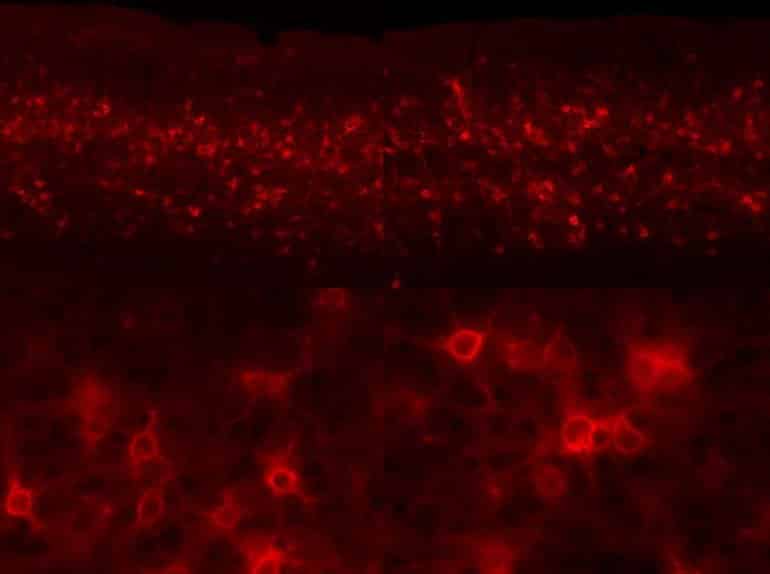Summary: Blocking the matrix metalloproteinases MMP2 and MMP9 can have the opposite effect on neuroplasticity depending on whether the brain is healthy or injured.
Source: University of Gottingen
The brain is a remarkably complex and adaptable organ. However, adaptability decreases with age. As new connections between nerve cells in the brain form less easily, the brain’s plasticity decreases.
If there is an injury to the central nervous system, such as after a stroke, the brain needs to compensate by reorganizing itself. To do this, a dense network of molecules between the nerve cells—known as the extracellular matrix—must loosen.
This is the job of a wide variety of enzymes that ultimately regulate how plastic or how stable the brain is. Researchers at the University of Göttingen studied what happens when certain enzymes are blocked in mice. Depending on whether the brain is healthy or diseased, the inhibition had opposite effects.
The results were published in the Journal of Neuroscience.
Learning and recovery from injuries depend on the plasticity of neuronal connections. Macromolecules of the extracellular matrix, located between the nerve cells, are important for plasticity.
As people grow up, the stability of this extracellular matrix increases, providing a scaffold for stabilizing existing connections between the nerve cells, and consolidating information. If someone experiences something new, the extracellular matrix must be loosened to allow new connections to form.
This relationship between stability and plasticity in the brain is regulated in the matrix with the help of enzymes such as matrix metalloproteinases (MMPs), which can “digest” the extracellular matrix and thus “loosen” it.
A team from the University of Göttingen has now been able to show in a new study that blocking the matrix metalloproteinases MMP2 and MMP9 can have opposing effects depending on whether the brain is sick or healthy.
To measure neuronal plasticity, the scientists let adult mice see only through one eye for several days and recorded the resulting activity changes in the animals’ visual cortex. They first examined the adaptability of the visual cortexes of healthy mice in which the enzymes MMP2 and MMP9 were blocked (with SB3CT).

As a result, neuronal plasticity was also blocked. In a second experiment, the team researched mice immediately after a stroke. It was already known that a stroke leads to a strong short-term increase in MMPs. In this case, the targeted, short-term inhibition of the enzymes MMP2 and MMP9 produced the opposite effect: The plasticity that had been greatly reduced by the stroke was restored, so blocking the enzymes MMP2 and MMP9 had a clear therapeutic effect.
“What made the design of our study different from many previous studies, is that the matrix-degrading enzymes were blocked only after the experimental stroke, which simulates treatment,” says Professor Siegrid Löwel from the Department of Systems Neuroscience at Göttingen University.
“We also show that the MMPs in the brain have to be very well monitored and precisely adjusted. Too low a level in the healthy brain prevents neuronal plasticity and too high a level—as after a stroke—also blocks neuronal plasticity.”
About this neuroplasticity research news
Author: Press Office
Source: University of Gottingen
Contact: Press Office – University of Gottingen
Image: The image is credited to Siegrid Löwel
Original Research: Closed access.
“MMP2 and MMP9 Activity Is Crucial for Adult Visual Cortex Plasticity in Healthy and Stroke-Affected Mice” by Ipek Akol et al. Journal of Neuroscience
Abstract
MMP2 and MMP9 Activity Is Crucial for Adult Visual Cortex Plasticity in Healthy and Stroke-Affected Mice
A fundamental regulator of neuronal network development and plasticity is the extracellular matrix (ECM) of the brain. The ECM provides a scaffold stabilizing synaptic circuits, while the proteolytic cleavage of its components and cell surface proteins are thought to have permissive roles in the regulation of plasticity. The enzymatic proteolysis is thought to be crucial for homeostasis between stability and reorganizational plasticity and facilitated largely by a family of proteinases named matrix metalloproteinases (MMPs).
Here, we investigated whether MMP2 and MMP9 play a role in mediating adult primary visual cortex (V1) plasticity as well as stroke-induced impairments of visual cortex plasticity in mice. In healthy adult mice, selective inhibition of MMP2/9 for 7 d suppressed ocular dominance plasticity (ODP). In contrast, brief inhibition of MMP2/9 after a cortical stroke rescued compromised plasticity.
Our data indicate that the proteolytic activity of MMP2 and MMP9 is critical and required to be within a narrow range to allow adult visual plasticity.
SIGNIFICANCE STATEMENT
Learning and recovery from injuries depend on the plasticity of neuronal connections. The brain’s extracellular matrix (ECM) provides a scaffold for stabilizing synaptic circuits, while its enzymatic proteolysis is hypothesized to regulate homeostasis between stability and reorganizational plasticity.
ECM digestion is facilitated by a family of matrix metalloproteinases (MMPs). Here, we show that treatments that inhibit MMP2/9 can either inhibit or rescue cortical plasticity depending on cortical state: in the visual cortex of healthy adult mice, inhibition of MMP2/9 suppressed cortical plasticity.
In contrast, brief inhibition of MMP2/9 after a stroke rescued compromised plasticity. Our data provide strong evidence that an optimal level of MMP2/9 proteolytic activity is crucial for adult visual plasticity.






